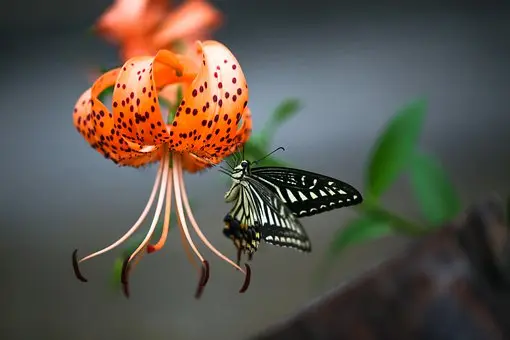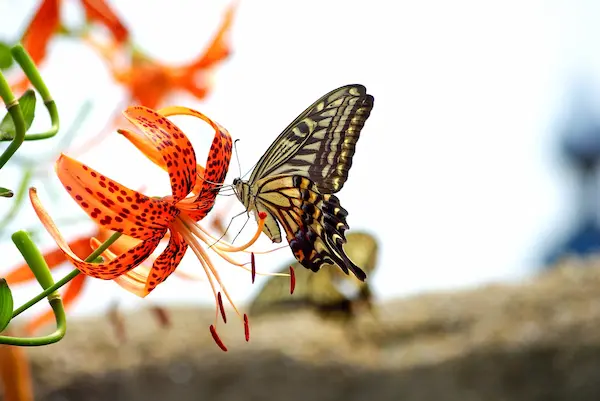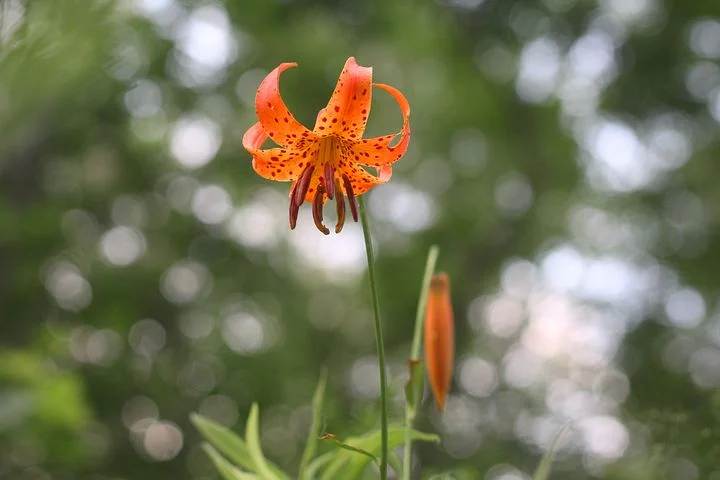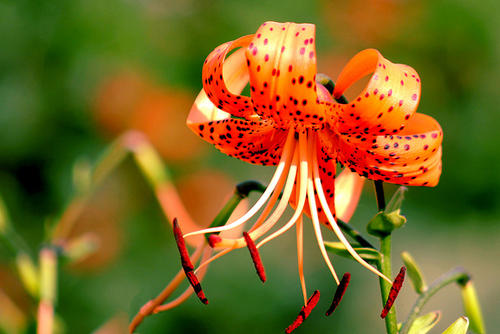Tiger Lily (Lilium Lancifolium) Profile: Info, Care & Growing Guide
Written by Maggie
Nov 22 2021

Tiger Lily, scientific name Lilium lancifolium, is an herbaceous perennial that grows from bulbs and produces strappy leaves and long stalks yielding colorful, stately flowers in the summertime. The petal of the Tiger Lily is either flat or curled outward, hence the name "Tiger Lily".
Tiger Lily Pictures


Tiger Lily Info
| Botanical Name | Lilium lancifolium |
| Common Names | Tiger Lily |
| Plant Type | Herbaceous perennial |
| Sun | Full sun to part shade |
| Hardiness Zones | 3–9 (USDA) |
| Flower color | Orange; red, yellow, white, and pink hybrids also available |
| Native Area | Eastern Asia |
| Mature size | 3–5 feet tall, spread of 7–8 inches |
| Bloom Time | Summer |
| Toxic | Toxic to cats |
Tiger Lily Characteristics
Tiger Lily Stems
Bulbs of Tiger Lily are sub broadly globose, about 3.5 cm high, 4 -- 8 cm in diameter; Scales are broadly ovate, 2.5-3 x 1.4-2.5 cm, white.Stem 0.8-1.5 m tall, purplish striped, with white woolly hairs.
Tiger Lily Leaf
Leaves of Tiger Lily are scattered, rectangular oblong-lanceolate or lanceolate, 6.5 -- 9 cm long, 1 -- 1.8 cm wide, glabrous on both surfaces, white hairs at apex, papillary at margin, with 5 -- 7 veins, beaded in upper leaf axils.
Tiger Lily Flowers
Tiger Lily has 3-6 flowers or more; Bracts are leafy, ovate-lanceolate, 1.5 -- 2 cm long, 2 -- 5 mm wide, apex obtuse, white woolly; Pedicels are 6.5 -- 9 cm long, purple, with white woolly hairs; Flowers are pendulous, perianth lanceolate, reflexed, orange-red, with purple-black spots; Outer perianth segments are 6 -- 10 cm long, 1 -- 2 cm wide; The inner perianth segment is slightly wider, and there are papillary processes on both sides of the nectaries, and tassel processes. The stamens spread on all sides; Filaments of Tiger Lily are 5 -- 7 cm long, reddish, glabrous, anthers rectangular, ca. 2 cm long; Ovary is cylindrical, 1.5 -- 2 cm long, 2 -- 3 mm wide; Style is 4.5 -- 6.5 cm long, stigma slightly enlarged, 3-lobed.
Tiger Lily Fruit
Capsule of Tiger Lily is narrow ovate, 3-4 cm long.
Tiger Lily Native Habits
In its native state, Tiger Lily is a deciduous plant, dormant mainly during the winter months, when cold weather, short days, and liquid water are scarce. After a short dormancy in summer, the basal rosette buds form in autumn, and the stem elongates and blossoms after overwintering. Seeds ripen in late summer. Tiger Lily likes a cool and humid environment, sunny, slightly shaded environment is more suitable for lily. Avoid drought, avoid heat, it's cold tolerance is a little worse. The growth and flowering temperature of lily is 16-24℃, and the growth almost stops when the temperature is lower than 5℃ or higher than 30℃. The Tiger Lily grows normally when the temperature is higher than 10℃, and the growth stops when the temperature is higher than 25℃. If the night temperature is lower than 5°C for 5-7 days in winter, the differentiation of flower buds and development of flower buds will be seriously affected, and the flowering will be delayed, even blind flowers and flower fission. Tiger Lily likes fertile, humus more deep soil, most avoid hard clay;Slightly acidic soils with good drainage are better, with a pH value of 5.5-6.5.

Tiger Lily Care
Tiger Lily Soil Care
Before planting Tiger Lily, soil disinfection should be carried out. The commonly used disinfection methods include steam disinfection and chemical disinfection. Steam disinfection is rarely used because it consumes much energy and is troublesome to operate. Chemical disinfection is to use 40% formalin mixed with 1∶50 or 1∶100 times of liquid medicine sprinkled on the soil, the amount of 2.5 kg/square meter, after sprinkling with plastic film covering 5-7 days, uncovered after 10-15 days of drying can be planted, or with carbendazim powder 8-10 g/square meter sprinkled into the soil for disinfection.
Tiger Lily Thaw
Thawing and disinfection of the pellets: open the package immediately after the pellets arrive and put Tiger Lily in the environment of 10-15°C for thawing. Disinfect the pellets after they are completely thawed. Disinfection method: put the bulb into 1/1000 of clendaniel, chlorothalonil, carbendazim, potassium permanganate and other aqueous solution to soak for 30 minutes, or put the bulb into 80 times of 40% formalin solution to soak for 30 minutes, after taking out, rinse the residual solution on the bulb with water, and then dry it in a cool place before planting. Some domestic planting bases, before transplanting, cut the original base root, so conducive to promoting new base roots.
Tiger Lily Storage
If the thawed pellets cannot be planted immediately, they cannot be refrozen, or there will be a risk of freezing damage. Tiger Lily can be stored at 0-2℃, but they can only be stored for two weeks at most.It can also be stored at 2-5℃ for up to a week, and the plastic film packaging must be opened at the same time.
Tiger Lily Density
Planting Tiger Lily in spring and summer requires a depth of 8-10 cm from the top of the bulb to the surface and 6-8 cm in winter. Planting density varies with species, bulb size, and season. Spring and summer, and can be planted densely, winter sunshine is weaker and should be planted sparsely.
Tiger Lily Temperature Care
In order to obtain high quality cut Tiger Lily, greenhouse temperature control is very important. The soil temperature must be kept at a low 9 to 13 ° C for 3-4 weeks after colonization to promote rooting. Too low a temperature will unnecessarily prolong the growth period, while temperatures above 15℃ will result in stunted stem and root development. These stem roots will soon replace the base roots to provide 90% of the plant's water and nutrients, so the development of stem roots is critical to obtaining high quality lily plants.A fter rooting, the ambient temperature of Tiger Lily should be controlled at 15-25℃. If the temperature is too high in the daytime, ventilation and shading should be used to reduce the temperature.If the night temperature reaches 15-25℃, Tiger Lily cut flower stem is short, less bud, quality is reduced, at this time with gibberellin solution spraying plant to increase the length of flower stem method, specific dosage varies due to different growth period, different environmental temperature, general growth early can be less, later can be more. The winter temperature in domestic solar greenhouse will generally prolong the growth period of lily, and seriously affect the quality of cut flowers, so we should increase the means of temperature regulation.

Tiger Lily Humidity Care
The soil moisture before planting should be tightly clenched and loose on the ground. In the season of higher temperature, before planting, if possible, cold water should be poured once to reduce the soil temperature. After transplanting, water is poured again, so that the soil and the seed ball fully contact, to create good conditions for the development of the stem and roots. After watering in order to keep the soil moist for the standard, namely the hand holding a soil into a group but not water is appropriate. Watering is generally chosen in the morning on a sunny day. Relative humidity should be 80%-85%. Relative humidity should avoid too large fluctuation, otherwise burning may occur.
Tiger Lily Fertilizer
The early stage of flowering lily ball growth mainly consumes the nutrients stored in its scales, so there is no need to add too much base fertilizer before transplanting. After a month of transplanting, some fertilizer can be applied according to the fertility of the land. Tiger Lily has a great demand for potassium, and the compound fertilizer can be prepared according to the ratio of N-P2O5-K2O =14∶7∶21. Apply 10 kg topdressing per acre every 10-15 days until 3 weeks before flower harvesting. At the same time should also pay attention to the supplement of trace elements, such as iron, boron, zinc and so on.
Tiger Lily Lighting Requirements
Light is an important condition for quality control, especially for Tiger Lily bud development. Insufficient light will cause poor plant growth and cause tiger lily buds to drop, leaf color and color of the flower will become shallow, the vase life will be shortened. During winter planting in northern China, about 25-30% of the sunlight is blocked due to the influence of insulation materials such as glass or plastic film. Therefore, in addition to keeping the surface of glass and plastic film clean to make it transparent to light, some varieties also need to make up light, which can be made up by incandescent lamps. Gardening high pressure sodium lamps should be used in good modern greenhouses. Summer production lily but also to avoid strong direct sunlight, generally with sunshade net shade. Asian and musk lily shading 40%, Oriental lily shading 50%.
Carbon dioxide is good for Tiger Lily growth and flowering.At 8-10 o 'clock in the morning on sunny days, apply carbon dioxide gas pellets in the unventilated shed to increase the carbon dioxide content in the shed. Also can use other methods, example: every 15 to 20 meters hanging a plastic bucket (height is 1 m barrels to the ground), bucket packed inside 20% of sodium bicarbonate (family in common use baking soda is sodium bicarbonate) solution, then gradually will match good points 3-4 times 10% of dilute sulphuric acid solution into the plastic, and baking soda reacts with sulfuric acid can generate carbon dioxide. A solar greenhouse 60 meters long and 7 meters wide requires 1.7 kg of pure sodium bicarbonate and 1 kg of concentrated sulfuric acid (98% concentration).

Tiger Lily Propagation
Tiger Lily propagation includes bulb propagation, scale cuttage, sowing propagation and tissue culture.
Tiger Lily Seed propagation
Sowing method belongs to sexual propagation and is mainly used in Tiger Lily propagation. The method is to gather seeds in the autumn and store them for sowing the following spring. Germinate about a day after sowing. Seedling period to appropriate shading. In autumn, the underground part has formed a small bulb, can be dug out. Depending on the species, some seedlings may take three years to bloom, while others may take many years to bloom. Therefore, this method is not suitable for families to adopt.
Read More:
How to Plant and Care for Tiger Lily Seeds
Tiger Lily Bulb propagation
This method can be used if propagation or several Tiger lilies are needed. There are usually small bulbs on the periphery of the stem disc of an old bulb. When the Tiger lillies are harvested in autumn, these bulbs can be separated and stored indoors in the sand for the winter. Plant potted Tiger Lily the next spring. Cultivated in autumn of the third year, can grow into large bulbs and cultivate into large plants. This method of reproduction is small, only suitable for family pot propagation.
Read More:
Tiger Lily Bulbs Growing and Planting
Tiger Lily Cutting propagation
Scaly cutting method. This method can be used for a medium number of propagation. Autumn dug bulbs, to old bulb enrichment, fleshy scales on item break down, each should scales at base, with a small number of stem slightly air-dried, then good cuttings in sheng river sand or vermiculite flowerpot or shallow wooden cases, let two-thirds of scales insert substrate, maintain a certain humidity, matrix under the condition of ℃ or so, about one and half months, scales wound took root. Winter temperature should be maintained at about 18℃, scale wounds that root.Winter temperature should be kept from the river sand too wet. Cultivated to the next spring, the base of the scales can grow small bulbs, they are separated, planted in the pot. Be carefully guarded.
Tiger Lily Points pearl propagation
The sprouting method is only suitable for a few species. For example, lily, such as roll Dan, yellow iron gun, multi-purpose this method. Practice is: will be on the stem and leaf axils of the formation of the small bulb (also known as "bead bud", in summer bead bud has fully grown, but has not fallen off) take down culture. It usually takes two to four years from large bulb to flower.
Tiger Lily Pests & Diseases
Tiger lilies are a resilient species and don't seem to be very prone to disease. However, they can harbor viruses, such as lily mosaic virus, that can damage different kinds of lilies.4 If you suspect this disease, the plant and bulbs ought to be pulled and destroyed (don't add the cloth to a compost bin).
Tiger lilies beetles (Lilioceris lilii) and aphids can be challenging pests for the lilies. So deal with your vegetation as quickly as feasible if you are aware the leaves are being damaged.
Tiger Lily Toxicity
Although the bulbs and plants of Tiger Lily are pretty suitable for eating for people (the plant used to be probably bred for that purpose), the pollen may additionally be mildly poisonous to people and animals. The story is distinct for cats, for whom all components of the plant are severely poisonous.
Ingestion of Tiger Lily pollen in extent has been acknowledged to motive vomiting in people and animals. For cats, Tiger Lily is pretty significantly toxic.3 Even small ingestion of a petal, leaf, pollen—or even water from a vase of reduced flowers—can end in acute kidney failure. Symptoms of toxicity consist of lethargy, vomiting, and a lack of appetite. If you suspect your cat has ingested any section of one of these lilies, convey the cat (and the plant) at once to a veterinarian for clinical care. Generally, the faster remedy is started, the higher the prognosis.

Tiger Lily Distribution
Tiger Lily grows under shrubs, grasslands, along roads or by water, at an altitude of 400-2500 meters.
Tiger Lily is produced in Jiangsu, Zhejiang, Anhui, Jiangxi, Hunan, Hubei, Guangxi, Sichuan, Qinghai, Xizang, Gansu, Shaanxi, Shanxi, Henan, Hebei, Shandong and Jilin provinces of China.
Tiger Lily is grown everywhere.Japan, Korea also have distribution.
Tiger Lily Uses
Garden Use
The Tiger Lily is called "Tiger Lily" because of its flaming red petals. Plant it in the yard and enjoy the flowers in summer. Tiger Lily has become an important ornamental flower abroad. Its flower shape is a peculiar, swaying scene, not only suitable for garden flower beds, flower borders and garden planting, but also cut flowers and potted good materials.
Medical Use
The bulb of Tiger Lily is rich in starch, which is used as food and medicine. The flowers contain aromatic oil and are used as fragrances .In China, tiger lily bulbs are more useful for soups when dried, and many parts of the plant are used as medicine.
Latest Updated
- Benefits of Bugleweed - 7 Science-backed Health Benefits
- Bugleweed Dangers & Side Effects - Is It Poisonous?
- How to Plant Evergreen Trees - What You Should Know
- When to Plant Evergreens - Grow Guide for Evergreen Trees
- 12 Wonderful Evergreen Shrubs for Your Garden
- 12 Popular Evergreen Plants with Pictures for Beginners
- When And How To Prune A Lilac Bush Like a Pro
- How to Grow & Care for Lilac Vine (Hardenbergia Violacea)
- Japanese Lilac Tree (Syringa Reticulata) Care & Propagation Guide
- Shumard Oak Pros and Cons - What to Know
Popular Articles
- Winter maintenance of Antirrhinum Majus
- How to Grow Terminalia Mantaly Tree
- How to Grow and Care for Crossostephium Chinense
- How to grow Antirrhinum Majus in spring
- Peristeria Elata (Dove Orchid) Profile: Info & Care Guide
- Underwatered Snake Plant (Sansevieria Trifasciata) - Signs And How To Fix
- How to Care for Brazilian Jasmine Plant (Mandevilla Sanderi)
- How to Grow & Care for Graptopetalum Purple Delight in Summer
- Rosa Chinensis (China Rose): Plant Growing & Care Tips
- How to Care for Baby Sun Rose (Aptenia Cordifolia)